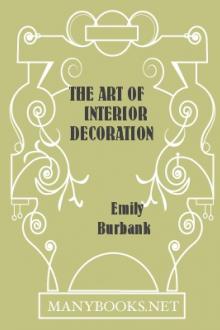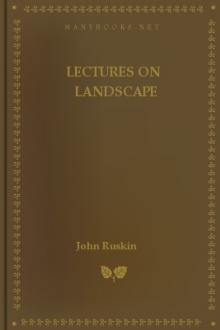The Seven Lamps of Architecture by John Ruskin (books like harry potter TXT) 📕

- Author: John Ruskin
- Performer: -
Book online «The Seven Lamps of Architecture by John Ruskin (books like harry potter TXT) 📕». Author John Ruskin
VIII. What is needful in the setting forth of magnitude in height, is right also in the marking it in area—let it be gathered well together. It is especially to be noted with respect to the Palazzo Vecchio and other mighty buildings of its order, how mistakenly it has been stated that dimension, in order to become impressive, should be expanded either in height or length, but not equally: whereas, rather it will be found that those buildings seem on the whole the vastest which have been gathered up into a mighty square, and which look as if they had been measured by the angel's rod, "the length, and the breadth, and the height of it are equal," and herein something is to be taken notice of, which I believe not to be sufficiently, if at all, considered among our architects.
Of the many broad divisions under which architecture may be considered, none appear to me more significant than that into buildings whose interest is in their walls, and those whose interest is in the lines dividing their walls. In the Greek temple the wall is as nothing; the entire interest is in the detached columns and the frieze they bear; in French Flamboyant, and in our detestable Perpendicular, the object is to get rid of the wall surface, and keep the eye altogether on tracery of line; in Romanesque work and Egyptian, the wall is a confessed and honored member, and the light is often allowed to fall on large areas of it, variously decorated. Now, both these principles are admitted by Nature, the one in her woods and thickets, the other in her plains, and cliffs, and waters; but the latter is pre-eminently the principle of power, and, in some sense, of beauty also. For, whatever infinity of fair form there may be in the maze of the forest, there is a fairer, as I think, in the surface of the quiet lake; and I hardly know that association of shaft or tracery, for which I would exchange the warm sleep of sunshine on some smooth, broad, human-like front of marble. Nevertheless, if breadth is to be beautiful, its substance must in some sort be beautiful; and we must not hastily condemn the exclusive resting of the northern architects in divided lines, until at least we have remembered the difference between a blank surface of Caen stone, and one mixed from Genoa and Carrara, of serpentine with snow: but as regards abstract power and awfulness, there is no question; without breadth of surface it is in vain to seek them, and it matters little, so that the surface be wide, bold and unbroken, whether it be of brick or of jasper; the light of heaven upon it, and the weight of earth in it, are all we need: for it is singular how forgetful the mind may become both of material and workmanship, if only it have space enough over which to range, and to remind it, however feebly, of the joy that it has in contemplating the flatness and sweep of great plains and broad seas. And it is a noble thing for men to do this with their cut stone or moulded clay, and to make the face of a wall look infinite, and its edge against the sky like an horizon: or even if less than this be reached, it is still delightful to mark the play of passing light on its broad surface, and to see by how many artifices and gradations of tinting and shadow, time and storm will set their wild signatures upon it; and how in the rising or declining of the day the unbroken twilight rests long and luridly on its high lineless forehead, and fades away untraceably down its tiers of confused and countless stone.
IX. This, then, being, as I think, one of the peculiar elements of sublime architecture, it may be easily seen how necessarily consequent upon the love of it will be the choice of a form approaching to the square for the main outline.
For, in whatever direction the building is contracted, in that direction the eye will be drawn to its terminal lines; and the sense of surface will only be at its fullest when those lines are removed, in every direction, as far as possible. Thus the square and circle are pre-eminently the areas of power among those bounded by purely straight or curved lines; and these, with their relative solids, the cube and sphere, and relative solids of progression (as in the investigation of the laws of proportion I shall call those masses which are generated by the progression of an area of given form along a line in a given direction), the square and cylindrical column, are the elements of utmost power in all architectural arrangements. On the other hand, grace and perfect proportion require an elongation in some one direction: and a sense of power may be communicated to this form of magnitude by a continuous series of any marked features, such as the eye may be unable to number; while yet we feel, from their boldness, decision, and simplicity, that it is indeed their multitude which has embarrassed us, not any confusion or indistinctness of form. This expedient of continued series forms the sublimity of arcades and aisles, of all ranges of columns, and, on a smaller scale, of those Greek mouldings, of which, repeated as they now are in all the meanest and most familiar forms of our furniture, it is impossible altogether to weary. Now, it is evident that the architect has choice of two types of form, each properly associated with its own kind of interest or decoration: the square, or greatest area, to be chosen especially when the surface is to be the subject of thought; and the elongated area, when the divisions of the surface are to be the subjects of thought. Both these orders of form, as I think nearly every other source of power and beauty, are marvellously united in that building which I fear to weary the reader by bringing forward too frequently, as a model of all perfection—the Doge's palace at Venice: its general arrangement, a hollow square; its principal façade, an oblong, elongated to the eye by a range of thirty-four small arches, and thirty-five columns, while it is separated by a richly-canopied window in the centre, into two massive divisions, whose height and length are nearly as four to five; the arcades which give it length being confined to the lower stories, and the upper, between its broad windows, left a mighty surface of smooth marble, chequered with blocks of alternate rose-color and white. It would be impossible, I believe, to invent a more magnificent arrangement of all that is in building most dignified and most fair.
X. In the Lombard Romanesque, the two principles are more fused into each other, as most characteristically in the Cathedral of Pisa: length of proportion, exhibited by an arcade of twenty-one arches above, and fifteen below, at the side of the nave; bold square proportion in the front; that front divided into arcades, placed one above the other, the lowest with its pillars engaged, of seven arches, the four uppermost thrown out boldly from the receding wall, and casting deep shadows; the first, above the basement, of nineteen arches; the second of twenty-one; the third and fourth of eight each; sixty-three arches in all; all circular headed, all with cylindrical shafts, and the lowest with square panellings, set diagonally under their semicircles, an universal ornament in this style (Plate XII., fig. 7); the apse, a semicircle, with a semi-dome for its roof, and three ranges of circular arches for its exterior ornament; in the interior of the nave, a range of circular arches below a circular-arched triforium, and a vast flat surface, observe, of wall decorated with striped marble above; the whole arrangement (not a peculiar one, but characteristic of every church of the period; and, to my feeling, the most majestic; not perhaps the fairest, but the mightiest type of form which the mind of man has ever conceived) based exclusively on associations of the circle and the square.
I am now, however, trenching upon ground which I desire to reserve for more careful examination, in connection with other æsthetic questions: but I believe the examples I have given will justify my vindication of the square form from the reprobation which has been lightly thrown upon it; nor might this be done for it only as a ruling outline, but as occurring constantly in the best mosaics, and in a thousand forms of minor decoration, which I cannot now examine; my chief assertion of its majesty being always as it is an exponent of space and surface, and therefore to be chosen, either to rule in their outlines, or to adorn by masses of light and shade those portions of buildings in which surface is to be rendered precious or honorable.
XI. Thus far, then, of general forms, and of the modes in which the scale of architecture is best to be exhibited. Let us next consider the manifestations of power which belong to its details and lesser divisions.
The first division we have to regard, is the inevitable one of masonry. It is true that this division may, by great art, be concealed; but I think it unwise (as well as dishonest) to do so; for this reason, that there is a very noble character always to be obtained by the opposition of large stones to divided masonry, as by shafts and columns of one piece, or massy lintels and architraves, to wall work of bricks or smaller stones; and there is a certain organization in the management of such parts, like that of the continuous bones of the skeleton, opposed to the vertebræ, which it is not well to surrender. I hold, therefore, that, for this and other reasons, the masonry of a building is to be shown: and also that, with certain rare exceptions (as in the cases of chapels and shrines of most finished workmanship), the smaller the building, the more necessary it is that its masonry should be bold, and vice versâ. For if a building be under the mark of average magnitude, it is not in our power to increase its apparent size (too easily measurable) by any proportionate diminution in the scale of its masonry. But it may be often in our power to give it a certain nobility by building it of massy stones, or, at all events, introducing such into its make. Thus it is impossible that there should ever be majesty in a cottage built of brick; but there is a marked element of sublimity in the rude and irregular piling of the rocky





Comments (0)